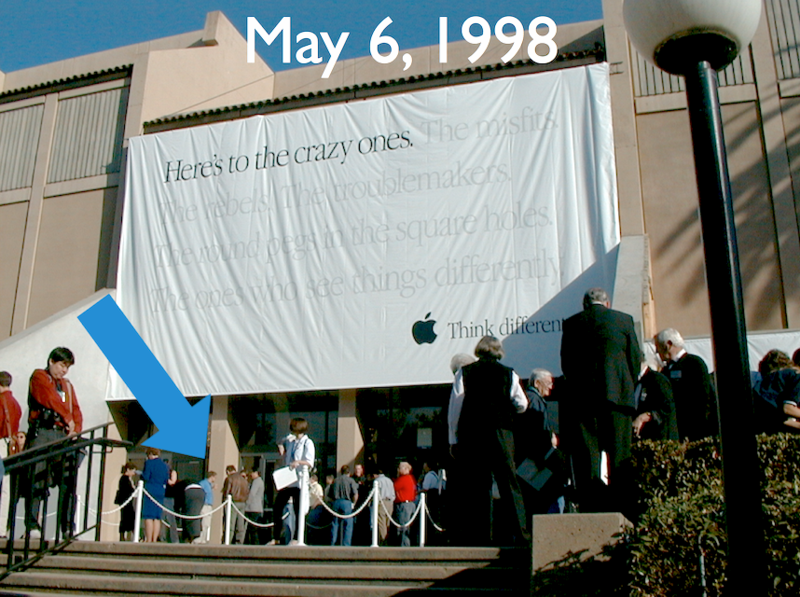The image above points to me standing out side Flint Center holding back the press corp before the iMac was introduced on May 6, 1998.
Reposted from July 2012. Here is Part One of this story.
One of my favorite Steve Jobs interactions concerning the iMac happened while we were working hard on the first of those five suggestions which helped turned Apple around: reconstituting the Apple University Consortium (AUC).
In the late 1980s, shortly after Steve launched the original Macintosh he faced a similar problem to the one we were facing ten years later. Very few developers were interested in building software for a platform that was much smaller than the standard at the time (in 1987 it was MS-DOS, in 1997 it was Windows). Steve’s answer was simple: encourage higher education institutions to build software for the platform and hook students on the Macintosh, which they would later bring to their jobs after graduation. The AUC worked exceedingly well then, and so I suggested to Steve that we rebuild a similar program, and he emphatically agreed.
We invited the CIOs or CTOs of 28 leading universities across the United States and Canada to the new Apple University Consortium. These representatives traveled to Cupertino every four months and met in closed-door sessions with Steve in order to secretly help us design and even build some of the software for the new computer. We knew that if we opened the kimono to these individuals, who had a real hand in creating the software, then they might commit to buying these computers for their schools. It was a great partnership as the education market had an unspoken vested interest in seeing us survive. Apple’s death would have been very challenging for many major schools like Dartmouth College (my former customer), who had not only standardized on the Mac but who would face a very tough and expensive (not to mention embarrassing) future if they would have to replace the Mac.
During one early morning meeting with the AUC members in our Executive Briefing Center in Cupertino, Steve arrived pushing a cart with a shroud covering a bulging object on top of it. Steve started by asking the audience about their ideas for the ideal computer for education (even though he already had a pretty good idea.) He asked a bunch of questions, and he let each one linger in the air before allowing anyone to respond.
Would it need wireless networking?
Did it need a handle to move it from lab to office?
Did it need more than one headphone jack so that students could share language lessons?
Did it need to be beautiful?
After dispensing with the warm-up act, Steve pushed the cart into the middle of the u-shaped conference room table, and he immediately pulled off the sheet to reveal a crude yet heavy Styrofoam model of an early iMac (known then as P1 or Prototype One). Then he did something that I’ll never forget, and in retrospect it was quintessentially Steve Jobs. He picked up the prototype, he refused to let anyone touch it, and he walked to the first person seated at the end of the conference table. Then he made an impromptu physical presentation exclusively to that person. He turned the model around 360 degrees; he showed the top and the bottom of it, and then he rotated it back another 360 degrees in the opposite direction as he described each intricate detail of his prototype. Then, while holding the model chest high and with its front facing out from his body, he took a half sidestep to his left in order to face the next person at the conference table, and he repeated the exact same presentation! There were probably 30 or more people seated around that conference table, which included some Apple employees, for whom Steve Jobs did that little dance.
He spent exactly the same amount of time, about 45 seconds, and he acted just like a proud father as he clearly showcased the merits of the product even though it was still a crude Styrofoam model. While he convinced all of us, it seemed to me that Steve was also convincing himself that this was the computer that would save Apple. It was an object with which everyone, even these staid IT professionals, could fall in love.
That was the beginning of the current age in which great design and great marketing can make computers, music players, and phones the objects of our lust and desire.
Next up: Why was I at the public launch of iMac?
Learn more: LogRocket just published this YouTube video where I talk about some of those days at Apple working for Steve Jobs.
